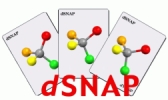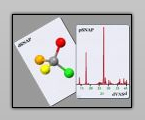Publishing Results
Click here to find out how to optimise dSNAP and PolySNAP graphics displays for publication.
Compare programs
Click here for an overview comparing dSNAP, PolySNAP and PolySNAP M.
SNAP software is developed
by the
Theoretical Crystallography group at the University of Glasgow, and is
exclusively distributed by Bruker AXS.
dSNAP
Update April 2009: dSNAP
1.0
- New version of dSNAP version was launched at BCA Spring Meeting, Loughborough, April 21 - 23 2009
- Click here to download the new version for free!
Introduction
The continued increase
in the number
of entries in the Cambridge Structural Database (CSD; Allen, 2002)
poses problems: it is an enormously powerful resource, but with more
than 300,000 entries, extracting meaningful chemical information can be
daunting. dSNAP
assists in this by letting the user:

- Import structural information
- Define local chemical symmetry
- Perform cluster analysis
- Similar fragments are easily identified
- Perform separate analysis on variables
- Distance/angle trends and outliers in search can be analysed
- Visualise real structures to understand the chemistry underlying the groupings

Primary Program Reference
dSNAP: A computer program to cluster and classify Cambridge Structural Database searchesBarr, G., Dong, W., Gilmore, C. J., Parkin, A. and Wilson, C. C. J. Appl. Cryst. (2005). 38, 833-841
Other References
Identifying structural motifs in inter-molecular contacts using cluster analysisPart 2. Interactions of carboxylic acids with secondary amides
Collins, A., Parkin, A., Barr, G., Dong, W., Gilmore, C.J. and Wilson, C. C. CrystEngComm, (2006). 8, In Press
Identifying structural motifs in inter-molecular contacts using cluster analysis
Part 1. Interactions of carboxylic acids with primary amides and with other carboxylic acid groups
Parkin, A., Barr, G., Dong, W., Gilmore, C. J., Parkin, A., and Wilson, C. C. CrystEngComm, (2006). 8, 257 - 264
Example work done with dSNAP
The application of cluster analysis to identify conformational preferences in enones and enimines from crystal structural data
Collins, A., Barr, G., Dong, W., Gilmore, C.J., Middlemass, D.S., Parkin, A. and Wilson, C. C. Acta Cryst, (2007). B63, 469-476





